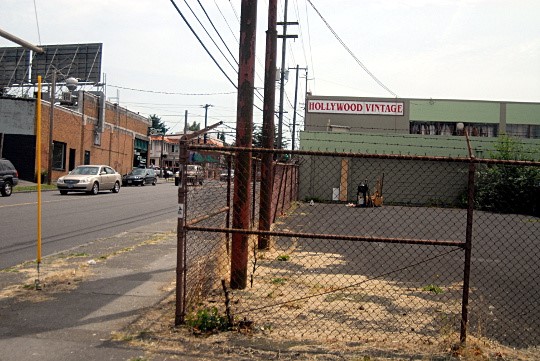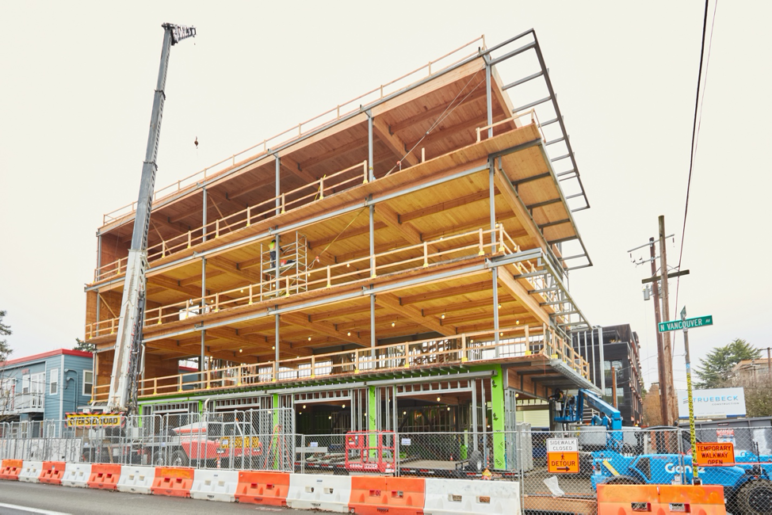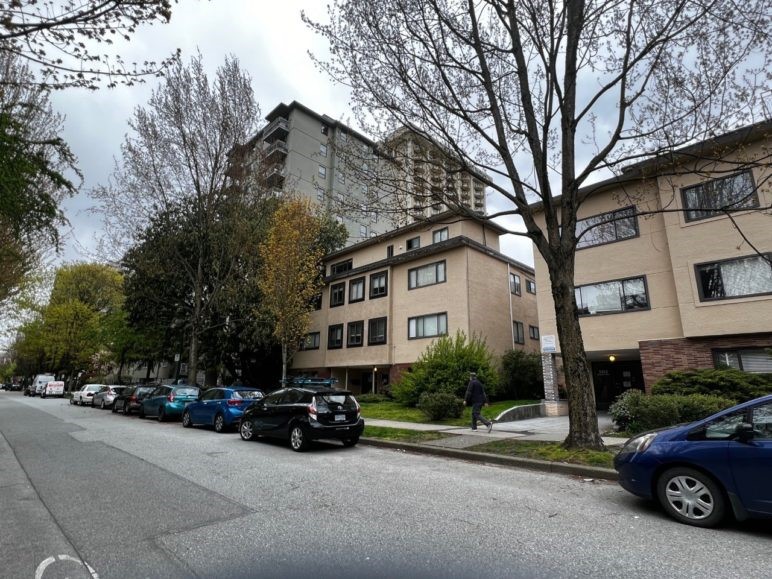On Thursday, Oregon approved the largest rollback to parking mandates in modern US history.
The unanimous vote by the state’s land use commission came through an unusual channel: an administrative action, ordered by the governor, that breathed new ambition into the broadly written land use laws that have gradually shaped Oregon for 50 years.
The law in question gives the state board the power to set land use rules that, among other things, “minimize adverse social, economic, and environmental impacts and costs.”
As Sightline has been arguing for decades, including in a new series over the last year, parking mandates create those costs. Lots of them.
Beginning January 1, 2023, Oregon is scheduled to do more to cut those costs than any other US state or Canadian province. In some situations—within a half-mile of relatively frequent transit; for homes of 750 square feet or less; for homes meeting affordability targets—minimum parking mandates will no longer apply for jurisdictions within Oregon’s eight largest metro areas. This doesn’t prevent parking lots from being built, but it does remove the current prevailing requirements to construct a specific number of stalls: one stall per bedroom, for example, or three per 1,000 square feet of retail space.
Farther from transit, jurisdictions in the state’s eight largest metro areas will have more flexibility in how to gradually make driving less necessary. In all, 48 cities and 5 counties representing about two-thirds of the state’s population are subject to the reforms. By the end of June 2023, the affected cities and urbanized unincorporated areas will need to choose from a branching menu of options on how to manage parking. In every case, jurisdictions will be able to comply simply by making off-street parking fully optional.
The commission did decide to give the Portland metro area a bit of additional flexibility. Its regional government is allowed to come up with its own parking rules, but the state commission must sign off that they are at worst equivalent to the statewide rules.
After several rounds of delays to the reform timeline, the Land Conservation and Development Commission (LCDC) unanimously voted Thursday for the sooner of two deadlines for putting the new rules in place.
“Science is dictating that we should be acting now,” said Barbara Boyer, an LCDC member and family farmer outside McMinnville, Oregon.
The proposal had drawn support from a coalition of 41 organizations that advocate for affordable housing, the environment, local businesses, and better transportation.
The new parking rules are part of a larger package called “Climate-Friendly and Equitable Communities” that industry groups, including the Oregon Home Builders Association and Oregon Association of Realtors, oppose. Though those groups hadn’t singled out the parking reforms for much criticism, they objected to other parts of the package. Meanwhile, various cities have also objected, arguing that the new rules are too prescriptive and would take considerable resources to implement.
But assuming these new rules survive legal challenge, people looking to build new homes and businesses, or dreaming of renovating an older building, can look forward to deciding for themselves how much parking their property needs. In many cases, it will be the first time since the 1950s that property owners are able to do so.
What will this mean for other Oregonians? Probably not much, for a while. But as the years go by, here are five things they might start to notice.
1. Vacant buildings will come back into use

Employees celebrate the opening of Atlas the Restaurant in a newly renovated historic building in Fayetteville, Arkansas. Until Fayetteville removed commercial parking mandates in 2015, it would have been illegal to use the building as a restaurant without special permission. Photo: Atlas the Restaurant. Used with permission.
One of the most visible ways a passerby might notice the elimination of parking mandates is that formerly vacant buildings might quickly get a makeover. Even in small cities like Fayetteville, Arkansas, city leaders are keeping their local economy vibrant by eliminating parking requirements. Keep your eyes on these types of buildings:
- Historic properties: Buildings constructed prior to parking requirements pose a particular problem for redevelopment. There is often no way these buildings can comply with modern parking mandates without a lengthy and expensive process to get an exception from the city. Oregon’s new parking rules bring these buildings back into play.
- Change-of-use properties: What can someone do with an office building left vacant by a pandemic? Maybe not much, if the parking lot is too small. For decades, cities’ zoning codes have defined different parking ratios for nearly every type of business. For example, a retail store might require more parking than an office, and a restaurant more than a retail store. With parking requirements out of the way, business owners who want to adapt will find many more properties available.
2. Businesses will start sharing underused parking lots

An unused parking lot managed by the Hollywood Vintage store in Portland, 2014. Photo: Michael Andersen for BikePortland.org. Used with permission.
How does eliminating parking mandates benefit the numerous half-empty parking lots that already exist? Now freed from parking requirements, owners of these lots can start renting out extra space, creating a virtuous cycle that keeps money in the local economy.
These arrangements are already happening in Ecorse, Michigan, a suburb of Detroit, where parking mandates were eliminated in 2020. Nani Wolf, the planning and zoning administrator for the city, shared a recent example where a developer hoped to renovate a historic building as an event space. There was no parking on-site.
The town did not legally require any parking, but the developer didn’t want to create a nuisance for neighbors. So Wolf helped connect the developer with an adjacent business with a large parking lot the new event-space owners could rent. “That made turning the obsolete building into a functional building possible,” she said.
The cost-sharing helps on multiple levels. First, the new owner doesn’t have to pay to construct new parking, saving them anywhere between $10,000 to $60,000 per space. It also lets neighboring businesses turn unused parking spots into rental income. This new market for parking spaces keeps money local, explained Wolf. Supporting and attracting new businesses is a top priority for Ecorse, which adopted a new zoning code after the town’s top employer, US Steel, announced in late 2019 that its plant would cease operating.
3. Projects will start construction faster

Mixed-use construction in Portland. Photo: Truebeck Construction. (Creative Commons)
In a city with parking mandates, you’ll be sure to find city planners hunched over their desks calculating how many parking spots each new building proposal requires according to the latest zoning code, then comparing that to the number of spaces in submitted plans. If the proposed building comes up short, there are sure to be follow up meetings with the developer, paperwork for variances, and often appearances before the zoning board or city council. That’s if everything goes smoothly.
“Parking is always the first thing that comes up with people objecting to the project,” said Nick Sauvie, executive director of the Portland-based affordable housing developer ROSE Community Development. When new development is politically contentious, a project might take months or years to win approval from neighborhood groups and public bodies.
A lot of this work can simply disappear once cities decide to get out of the business of inspecting parking lots. This can save time and money for both city staff and developers alike. As Oregon works to double its housing construction over the coming decades to alleviate its severe shortage of homes, reducing delays for things like parking will help.
4. Cities will actually start doing something about crowded curbs

In the West End neighborhood of Vancouver, garage spaces sat empty despite chronic shortages of curb parking—until the city raised the price of street parking permits. Photo by Gordon Price of Viewpoint Vancouver.
Spending less time micromanaging private parking lots will still leave city planners plenty to do. Now, they’ll be able to focus on a truly public issue: on-street parking.
In most of the United States and Canada, curbside parking is currently a free-for-all. If you can afford to show up alongside almost any street with a $15,000 machine, you’re allowed to occupy that real estate for almost as long as you like, free of charge—no matter if a nearby resident, worker, delivery van, or customer needs it more.
Parking mandates address this problem with the subtlety of a sledgehammer. Annoyed by crowded curbs? No problem, parking mandates say. We’ll just make urbanization illegal.
Oregon’s new rules take away the sledgehammer and instead push into local hands a little box of precision tools: time limits, annual permits, meters, loading zones, disability priority spaces. Different tools will fit different situations. That’s the whole point.
In some crowded places, meters and permits will also raise public money that can be used to improve walking, biking, or transit.
Meanwhile, in less crowded areas, the current free-for-all will continue to work just fine.
Because buildings take a while to build, Oregon cities will have at least a few years before the new rules have any actual effect on curbside parking. In the meantime, hope and expect that cities will start considering their options. The state land use agency says it’s eager to help with both cash and technical information.
“This is where the real work really begins,” state planner Kevin Young told the land use commission Thursday. “We’re not going to be successful if local governments aren’t.”
5. More parking lots will get built
But parking reforms like Oregon’s don’t actually presume that a better world is possible. Their work is deeper. They allow better worlds to be possible.

You read that right.
Despite all this, the Oregon of 2032 will probably have more parking spaces than the Oregon of 2022. The new rules put a few new costs and limits on the size of new lots and garages but mostly just within designated “climate-friendly areas.” And because cars will remain extremely useful, parking spaces will keep getting built whether they’re mandatory or not.
“I applaud the flexibility that this provides to the private sector to provide the parking where it’s most needed,” LCDC Chair Anyeley Hallova said Thursday.
To those of us who dream of quieter, cleaner, greener, freer cities whose public spaces have been fully reclaimed from cars, it can seem inadequate to just make parking optional. Meanwhile, to those of us who would feel imprisoned without cars and enough parking to make them useful, it can be hard to envision a world where cars are truly less necessary.
But parking reforms like Oregon’s don’t actually presume that a better world is possible. Their work is deeper. They allow better worlds to be possible.
To reduce dependence on the car, Oregonians still need to make it pleasant to walk and bike, to fund mass transit, to start neighborhood businesses, and to create homes and jobs near one another. If they can’t, then today’s parking reforms will have little effect one way or another.
Instead, what these reforms do is give Oregonians a better chance to do all those things. They give Oregonians new opportunities to succeed.












Houston Ing
There are a couple of things that are problematic here. #1. If there were an overabundance of parking in Metro areas then this would be a great idea, but I am unsure if you have tried to go downtown in Portland or even the suburbs and find parking. Unless it is a dedicated lot, there is no parking and that is with the limited MAX routes and underused bus system. So now you are advocating for the removing of added parking when businesses get put in or change business utilization then more demand for parking will be needed, with less parking available. So for the climate, you will have vehicles circling blocks trying to find parking putting more emissions into the air or running down their batteries. #2. If business owners were altruistic and cared about the economy and the good of their communities over profit, then maybe this would work. But business is about profit, if you don’t profit then you don’t make money. Of course businesses are going to opt out of adding parking thus exacerbating the already crowded parking nightmare creating a situation where only the government (who can give tickets for expired meters) and parking companies (who can jack up their costs due to sky high demand) will make money. That money is going to negatively “charge” BIPOC communities who live in urban areas and save to have a vehicle to get to work, spend time with family or just want to get out of town. In essence taking away their ability to own a vehicle, because it will cost too much. This has already created a problem in suburban areas where government entities have narrowed streets so much that if a single vehicle is parked, it turns the street into one way traffic, leaving vehicles to stack up and idle waiting for other vehicles to pass while spewing dangerous greenhouse gasses into the atmosphere. If there were really any concern for BIPOC communities and the environment, you would be advocating for more parking with the addition of trees to produce oxygen and create urban forests. It almost seems like this was an article written by construction companies, parking companies, and government trying to find ways to make money together.
Michael Andersen
A nice thing happens when the government makes money: the gets to spend that money on things. Sightline will continue our work to advocate for revenue from parking permits and meters to be reinvested locally in making lower-energy transportation options more desirable, accessible, and affordable. We’ll also continue to push for states and cities to lift their bans on the lower-cost urban housing types that let anyone choose those options who can.
When was the last time you went downtown in Portland yourself? There’s plenty of curbside parking in most locations and even more in the city garages that currently sit mostly vacant most of the time. The main exception is after the parking meter hours. I admit it’s not perfect everywhere, but that’s in part because the city has chosen not to execute the adaptive pricing policies already approved by its own council.
Doug Knauer
Your deflection didn’t answer the writers very relevant question about automobile affordability for the many who are on the economic fringes. Also, parking permits and meters are not simply positive revenue generators. Permits need to be administered and enforced. Meters need to be serviced and the monies collected and accounted for.
Michael Andersen
Houston Ing’s argument on this seems to be that because some car owners are poor and/or BIPOC, we should continue to subsidize car ownership across the board (with the cost hidden inside the price of everything else everyone purchases) in the hope that some of the benefits will reach poor and/or BIPOC people.
Because car ownership is a disproportionately higher-income and white activity, this doesn’t make sense to me.
Sightline’s position is that we should improve people’s lives by giving them money, allowing abundant housing, and subsidizing services that are disproportionately needed by people on the economic fringes, not by subsidizing an activity that is done more by rich people than by poor people. This is the position I alluded to in my previous comment.
Sightline also supports more urban trees; just yesterday I attended our monthly “lunch and learn,” which was focused on shade equities and inequities. I’d be interested to understand Houston Ing’s ideas for supporting both more trees and more parking; to me they seem like a pretty straight tradeoff for one another, which is why various tree advocates in Oregon supported the parking reform described above.
You’re correct that parking meters and permits have costs as well as revenues. In the higher-demand locations where unpriced curbsides would be truly crowded and the meter/permit rates are high enough that one or more spaces are available on each block, the revenues generally exceed the costs.
Evan Manvel
There’s a fundamental question Houston’s argument ignores: who pays for parking now? As in, there’s a cost to providing parking, and someone’s paying for it. Originally paid by builders, then by buyers or renters, the cost of parking is currently hidden in the costs of goods, in lower wages, in more expensive housing, and soforth.
So BIPOC communities are already indirectly paying for parking, and generally those less fortunate are subsidizing the wealthier folks who own more cars and drive more, as Michael has noted. (Homeowners own about 50% more cars than renters, for example – and consume more parking, at the expense of those who drive less).
Providing more subsidized parking means more driving, which means more pollution, which harms BIPOC communities disproportionately.
I have not trouble parking in downtown Portland or the suburbs when I have traveled there. Pretty much every utilization study I’ve seen has demonstrated sufficient or overproduced parking. I know our brains can attach to the time we had to park and walk a couple blocks, but the data are there.
Kyle
How will this cause more parking lots be built? Seems like this will have the opposite effect; many contractors only build the bare minimum required for apartments which is far below the amount actually needed, which floods the streets.
Michael Andersen
The claim isn’t “more parking lots will be built than would have been built with the mandates.” The claim is “parking lots will continue to be built, and the state will continue to add parking spaces on net.”
Your assumption that (if I understand you correctly) developers always build the minimum number of spaces required by law isn’t correct. Most new apartment buildings in Portland have on-site parking even though it hasn’t been required since 2017. Same in the Tigard Triangle, even though none has been required there, either. You can read more about the Tigard numbers here. The reason is that developers and their lenders will lose lots of money if people don’t want to purchase space in their buildings.
The difference now is that developers will now have actual incentives to reduce the need for people to drive to their buildings, and they’ll be able to take advantage of specific local situations where there’s a half-empty lot across the street or an abundance of parking on the curb.
It’s correct that in the case where previously uncrowded curbs become crowded, that might be annoying to people who want to do the exact same thing … store their own cars for free on the same curbs. In my opinion, accommodating that desire for free car storage space everywhere on demand is not more important than ensuring that we have enough homes for everyone to live in, or enough jobs for anyone to have work.
Todd Boyle
Prediction #6: you will see more 3 and 4 units construction on ordinary R1 lots. In Eugene, at present, you’re not only required to have 1 parking space per unit but the parking has to be interior to the lot. That’s right– it can’t be in front of the lot.
So your dream home, tiny house, or cottage cluster will have a parking lot in the middle instead of a garden.
Eugene’s implementation of middle housing (HB2001 and Sb458) was pretty good. It went a bit further than HB2001 on 2,3,4-plexes, cottage clusters and row houses: it allowed them on every Residential lot rather than some lots in “all areas” of the city.
However Eugene still required on-site parking everywhere except a tiny number of lots 1/4 mile from EMX (their name for bus rapid transit). Which only runs thru heavily commercial and multiunit zoning. The state’s new rule will demolish this restriction!!
With great appreciation and gratitude I thank Governor Brown and the LCDC for ending our city’s power to *FORCE* all new housing to subsidize automobiles. This has always been highly unfair to lower income people as well as people like me who have ridden my bike since the 1950s and never driven a car for transportation. Yes folks it is possible, rewarding, and of course cheap.
The *only* scenario for cheap housing at this time is buy an old house, build 3 Tiny Houses, divide the lot and sell them in fee simple. With relief from parking requirements these will be lovely, beautiful places— the perfect starter home to begin building equity.
If you’re in Eugene please join First Quintile Housing group on FB for daily developments and analysis.
M Galimanis
The price one pays for housing is driven by what someone else is will to pay for the home or apartment next door to yours, how will this have any meaningful impact on housing cost?
Michael Andersen
Great question! The answer is embedded in your correct premise: this will allow newly built homes to be constructed in some locations at lower cost, and those new homes will be able to compete on the combination of price+quality with nearby existing homes. This will reduce the ability of the owners of those nearby existing homes to jack up their prices.
For example:
https://twitter.com/impiac/status/1558253395969921024?s=20&t=YS89lWnBb3hiJbpAcKnX1Q